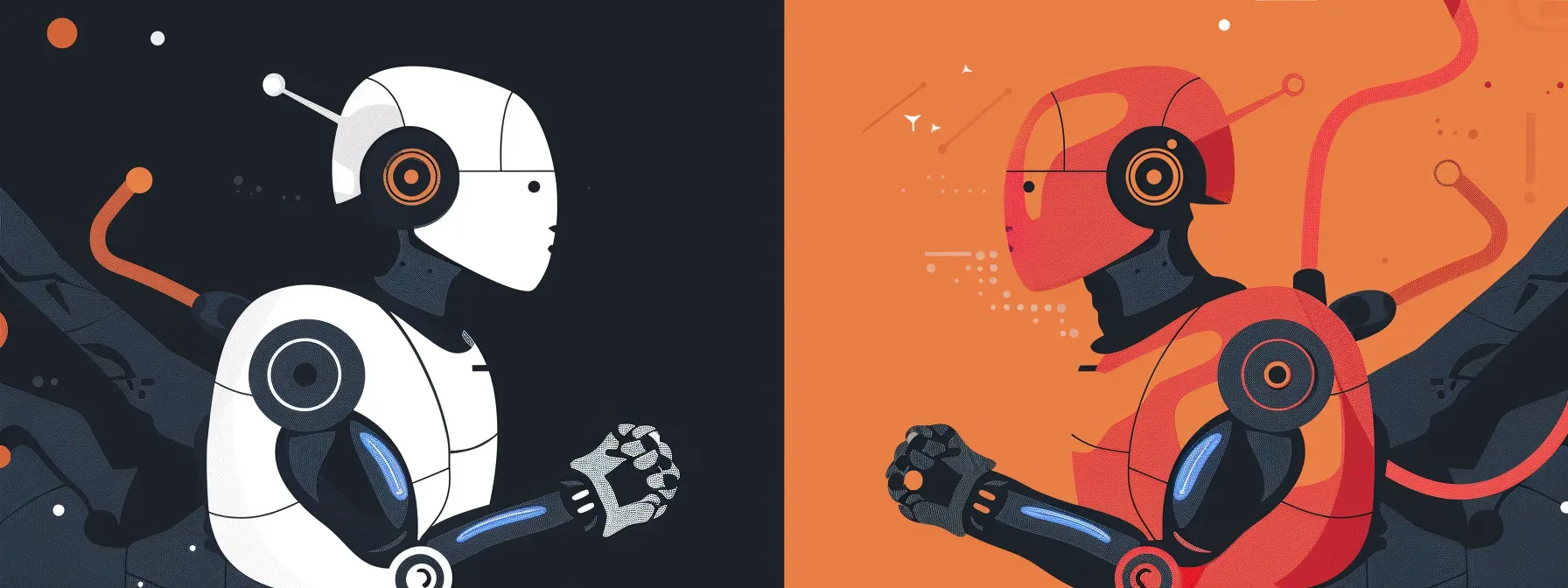
Exploring the Future of AI-Powered Chatbots vs Traditional Bots
By, Amy S
- 14 Feb, 2025
- 740 Views
- 0 Comment
In today’s fast-paced digital landscape, companies face the challenge of improving customer engagement while maintaining efficiency. Are traditional bots enough, or is it time to invest in AI-powered chatbots? This article will explore the differences between chatbot development systems, analyze the impact of AI on business communication, and discuss the challenges of implementing these technologies. By understanding these key points, readers will gain insights into how leveraging AI can enhance customer interactions and streamline operations, ultimately addressing their needs for improved cognition and responsiveness in customer service.
Understanding the Basics of AI-Powered Chatbots and Traditional Bots
AI-powered chatbots utilize advanced techniques like deep learning in chatbot development to offer enhanced information retrieval and personalization, allowing them to cater to user needs effectively. In contrast, traditional bots often face limitations, such as rigid response patterns and lack of adaptive learning. This section will compare these two technologies, highlighting how AI chatbots align with policies like the General Data Protection Regulation to provide compliant, responsive interactions.
Defining AI-Powered Chatbots and Their Functionalities
AI-powered chatbots leverage natural language understanding and advanced architecture to interpret user queries and provide context-aware responses. These chatbots utilize speech recognition technologies that allow them to engage in real-time conversations across various platforms, including social media. By adapting their responses based on user interactions, AI chatbots enhance the overall user experience and address specific needs effectively.
Identifying Traditional Bots and Their Limitations
Traditional bots often rely on a fixed knowledge base and scripted responses, which limits their ability to engage in dynamic conversations. Unlike AI-powered chatbots that harness advanced speech recognition capabilities, these basic bots struggle to adapt to user inputs, leading to frustrating interactions. For instance, while a user may expect a seamless exchange with platforms like Amazon Alexa, traditional bots may provide outdated or irrelevant information due to their rigid programming and lack of collaboration with evolving datasets, ultimately affecting user satisfaction.
Comparing AI-Powered Chatbots and Traditional Bots
AI-powered chatbots distinguish themselves from traditional bots through their advanced capabilities in predictive analytics and multimodal interaction, which significantly enhance user accessibility. While traditional bots rely on static programming, AI chatbots function as dynamic computer programs that learn from user behaviors and preferences. This adaptability not only improves user satisfaction but also turns each interaction into a valuable asset for businesses seeking to foster deeper engagement with their clientele.
Emerging Trends Shaping the Future of Chatbot Technology
Natural language processing plays a critical role in improving chatbot functionalities, enabling enhanced user interaction through emotional intelligence. Machine learning integration further personalizes customer support, transforming interactions into meaningful experiences. Additionally, the rise of multimodal interaction enriches the chatbot landscape, allowing diverse communication methods. Each of these trends shapes a future where chatbots provide smarter, more intuitive solutions to meet user needs.
The Role of Natural Language Processing in Chatbot Advancements
Natural Language Processing (NLP) is at the forefront of chatbot advancements, significantly reshaping how brands interact with customers. By leveraging large language models, these chatbots develop a deeper understanding of user intent, leading to predictions that enhance engagement in real-time. As commerce evolves with user expectations, NLP enables smoother and more authentic conversations, allowing brands to create meaningful connections with their audience while addressing their unique needs efficiently.
Integration of Machine Learning for Enhanced User Interaction
The integration of machine learning in chatbots significantly enhances user interaction by leveraging sophisticated algorithms to analyze user behavior. This technology allows for a deeper understanding of individual preferences, enabling chatbots to provide personalized responses that resonate with users. However, as these bots gain complexity in their operations, considerations around data security and the ethics of artificial intelligence become paramount, ensuring users’ information remains protected while fostering trust in automated interactions.
Increasing Focus on Personalization and User Experience
The increasing focus on personalization and user experience is transforming how chatbots, especially customer service chatbots, interact with users. Enhanced usability is achieved through adaptive learning, allowing virtual assistants to tailor their responses based on individual preferences and past interactions. This shift not only fosters customer satisfaction but also mitigates potential biases in service delivery, ensuring that every user receives relevant and timely support.
The Rise of Multimodal Interaction in Chatbots
The rise of multimodal interaction in chatbots represents a significant shift in how these technologies engage with users. By integrating various communication methods, including text, voice, and even augmented reality, chatbots can deliver a more seamless experience that enhances transparency and trust within society. For businesses, adopting multimodal chatbots not only fosters user engagement but also provides a competitive advantage, making effective use of data science to analyze user interactions across different platforms.
Analyzing the Impact of AI on Business Communication
AI-powered solutions are reshaping business communication by enhancing customer support through efficient infrastructure and integrating with the internet of things. They transform sales and marketing strategies via instant messaging and analytics, while also streamlining human resources interactions. This section will explore these impacts, focusing on practical implementations of chatbots that drive engagement and efficiency across organizations.
Improving Customer Support Through AI-Powered Solutions
AI-powered solutions significantly improve customer support by enhancing the user experience and fostering more effective onboarding processes. By implementing advanced conversational capabilities, these chatbots can address user emotions, providing empathy during interactions and transforming potentially frustrating scenarios into positive experiences. As highlighted by sources like MIT Technology Review, businesses embracing this concept witness higher satisfaction rates, as AI-driven support systems can quickly resolve issues and adapt to user preferences, ultimately driving engagement and loyalty.
Transforming Sales and Marketing Strategies With Chatbots
Chatbots are transforming sales and marketing strategies by streamlining processes through effective automation, enhancing customer engagement, and improving lead generation. In software development, smart bots analyze user interactions to better understand preferences, facilitating personalized recommendations that drive conversions. Research shows that addressing the uncanny valley effect—where bots appear too human-like—can improve user trust, ensuring communications resonate without crossing lines that may lead to skepticism or propaganda. Check out how AI chatbots can help your business grow to learn more about their potential impact.
Streamlining Internal Communication in Organizations
Streamlining internal communication within organizations, particularly in sectors like manufacturing, significantly benefits from AI-powered chatbots. These advanced tools utilize big data to analyze employee interactions, helping to facilitate effective information flow. For example, a recommender system can quickly match employees with relevant resources, ensuring that patient inquiries are addressed promptly and efficiently, thereby enhancing operational productivity and collaboration.
Exploring the Challenges Facing Chatbot Implementation
Implementing chatbot technologies involves navigating significant challenges, including addressing privacy and data security concerns that arise with user interactions. Furthermore, organizations often encounter resistance to change, hindering the adoption of advanced conversational agents. Lastly, managing user expectations and satisfaction is critical for success, particularly in evaluating interface effectiveness and utilizing databases to inform conversation strategies.
Addressing Privacy and Data Security Concerns
Addressing privacy and data security concerns is paramount in the development and implementation of chatbots, particularly in sensitive sectors such as health care. Organizations need to prioritize ethics in their design, ensuring that analytics are used responsibly to protect user information. By fostering transparent dialogue with users about data usage, companies can enhance productivity and build trust, alleviating concerns while improving overall engagement metrics.
Overcoming Resistance to Change Within Organizations
Overcoming resistance to change within an organization can be a significant challenge when implementing advanced chatbot solutions. Employees may feel apprehensive about new technologies affecting their roles, which can hinder customer engagement efforts. For successful integration, organizations should focus on creating a user interface that simplifies interactions and emphasizes the benefits of these tools, ultimately fostering a better understanding among consumers and staff about how AI-powered chatbots can enhance their workflows and improve engagement with customers.
Managing User Expectations and Satisfaction
Managing user expectations and satisfaction is crucial when implementing both AI-powered chatbots and traditional bots within customer service frameworks. Organizations need to align user perceptions with the capabilities of the deployed language model to avoid discrepancies that could impact revenue. For instance, a mobile app integrating advanced AI chatbot features can enhance user interactions by providing quick, relevant responses, ensuring a more satisfying customer experience that meets evolving demand.
Future Prospects for AI-Powered Chatbots and Traditional Bots
Predicting the evolution of chatbot technologies reveals significant implications for industries and users alike, particularly as natural language processing and machine learning advance. This section will examine potential job displacement and new opportunities arising from these innovations while assessing the long-term viability of traditional bots. The discussion will also touch on the influence of politics and giants like Google Assistant on the technological landscape.
Predicting the Evolution of Chatbot Technologies
As chatbot technologies evolve, the integration of advanced features such as sentiment analysis and home automation will redefine user interactions, particularly in sectors like healthcare and customer service. This innovation enables chatbots to offer personalized experiences that enhance customer satisfaction by accurately gauging user emotions and adapting responses accordingly. The future prospects of AI-powered chatbots indicate a shift towards more intuitive systems that not only assist customers but also provide valuable insights to businesses, fostering stronger connections and improved outcomes.
Examining Potential Job Displacement and New Opportunities
The integration of AI-powered chatbots presents both challenges and opportunities in the job market, particularly in enhancing the customer experience. As these intelligent systems take on customer support roles, there may be a reduction in traditional positions; however, this shift also creates new opportunities that require advanced knowledge of technology and data analytics. Organizations can expect to see a growing demand for skilled professionals capable of managing and optimizing AI systems, ensuring that customer interactions remain efficient and personalized.
Assessing the Long-Term Viability of Traditional Bots
The long-term viability of traditional bots appears increasingly challenged as user expectations and technological advancements evolve. These bots, which rely on predefined responses, often lack the flexibility needed to address dynamic user queries effectively. As businesses seek to improve engagement and customer satisfaction, many are shifting toward AI-powered solutions that can adapt and learn from interactions, ultimately positioning traditional bots as less favorable in future communication strategies.
Real-World Case Studies of Successful Chatbot Implementation
Industry leaders are increasingly adopting AI chatbots to enhance customer interactions, showcasing their effectiveness in various sectors. Conversely, several notable traditional bots remain in operation, highlighting their enduring relevance. This section will explore lessons learned from both successful and failed chatbot implementations, providing valuable insights into the practical applications of these technologies for businesses.
Industry Leaders Leveraging AI Chatbots
Industry leaders are increasingly adopting AI chatbots to streamline customer support and enhance user engagement. For instance, companies like Sephora utilize AI-driven chatbots to provide personalized product recommendations and assist customers in navigating their extensive catalog, significantly improving user satisfaction. These implementations showcase how businesses can leverage advanced chatbot technology to create seamless interactions and drive loyalty, effectively demonstrating the superiority of AI-powered solutions over traditional bots.
Notable Examples of Traditional Bots Still in Use
Despite the rise of AI-powered chatbots, several traditional bots remain in operation across various sectors, demonstrating their continued relevance. For example, many banking institutions utilize rule-based chatbots for automated customer service tasks, such as balance inquiries and transaction history requests. These bots effectively handle straightforward queries, ensuring a consistent user experience while allowing human agents to focus on more complex issues. Chatbot development services can help in creating such efficient bots.
Lessons Learned From Chatbot Deployment Successes and Failures
Lessons learned from both successful and failed chatbot deployments highlight the importance of understanding user expectations and capabilities of the technology. For instance, companies that meticulously analyzed customer interactions found that AI-powered chatbots significantly outperformed traditional bots in terms of user engagement and satisfaction. Conversely, businesses that implemented rule-based chatbots without considering user needs often faced frustrations, leading to missed opportunities for better customer service and retention.
Unlock the Power of AI for Your Business
At Digital Fractal Technologies, we specialize in AI chatbot development that transforms customer engagement and streamlines your business processes. Whether you’re looking to improve customer support, drive sales, or automate repetitive tasks, our AI-driven solutions are designed to help you stay ahead in a competitive market. Reach out to us today for a personalized consultation, and let’s explore how our chatbot development expertise can optimize your business operations and enhance customer experiences.
Category
- Android (12)
- Artificial Intelligence (49)
- Blockchain (10)
- Cloud Solutions (2)
- Cyber Security (3)
- Cybersecurity (8)
- Digital Transformation (71)
- Industry News (13)
- Infographics (10)
- iOS (4)
- Mobile App Development (99)
- Software (7)
- Uncategorized (38)
- Web development (15)
- Workflow Automation (4)
All Tag
Archives
- December 2025
- November 2025
- October 2025
- September 2025
- August 2025
- July 2025
- June 2025
- May 2025
- April 2025
- March 2025
- February 2025
- January 2025
- October 2024
- September 2024
- July 2024
- June 2024
- May 2024
- April 2024
- February 2024
- January 2024
- December 2023
- November 2023
- October 2023
- September 2023
- July 2023
- June 2023
- May 2023
- March 2023
- December 2022
- November 2022
- October 2022
- April 2022
- March 2021
- February 2021
- January 2021
- December 2020
- November 2020
- October 2020
- September 2020
- August 2020
- July 2020
- June 2020

